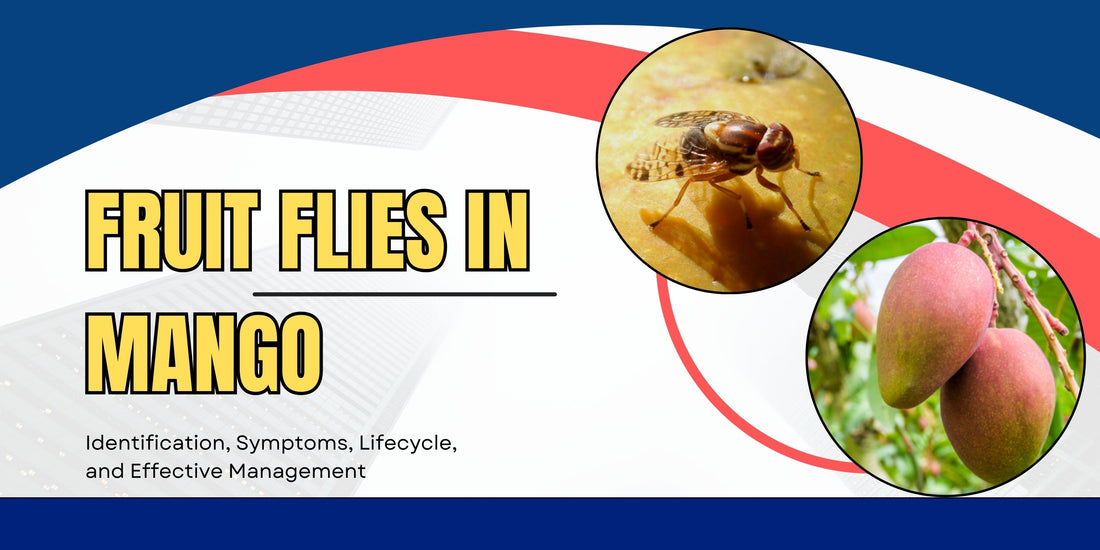
Mango Fruit Flies: Identification, Life Cycle, and Management
Share
Mangoes, often dubbed the "king of fruits," are not just popular among people — they’re also a favorite target for a notorious pest: the mango fruit fly. This pest, if left unchecked, can cause severe damage to mango crops, affecting both yield and fruit quality. Understanding how to identify, monitor, and manage mango fruit flies is essential for both small and commercial growers.
🔍 Identification of Mango Fruit Flies
The term "mango fruit fly" typically refers to several species within the Tephritidae family, especially:
- Bactrocera dorsalis (Oriental fruit fly)
- Bactrocera zonata (Peach fruit fly)
- Bactrocera correcta
Key Characteristics:
- Adult flies are about 6-8 mm long.
- They have a reddish-brown or yellowish body with distinct transparent wings.
- The abdomen is typically dark with yellow or orange markings.
- Wings have a distinctive "T" pattern.
- Larvae are creamy-white maggots that tunnel into the fruit pulp.
These flies are most active during warm, humid seasons, and females are capable of laying hundreds of eggs during their lifespan.
🔄 Life Cycle of Mango Fruit Flies
Understanding their life cycle is crucial for effective management. The mango fruit fly undergoes a complete metamorphosis in four stages: Egg → Larva → Pupa → Adult.
1. Egg Stage (1–2 days)
- Eggs are laid just beneath the skin of ripening fruit.
- A single female can lay up to 1,000 eggs in her lifetime.
2. Larval Stage (5–10 days)
- The hatched maggots feed on the fruit pulp, causing internal rotting.
- This stage causes the most damage and renders the fruit inedible.
3. Pupal Stage (10–14 days)
- Mature larvae drop to the ground and pupate in the soil.
- Pupal development depends on temperature and moisture conditions.
4. Adult Stage
- Adults emerge from the soil, mate, and begin the cycle again.
- Under optimal conditions, the full life cycle can complete in 2-3 weeks.
🛡️ Management of Mango Fruit Flies
Controlling mango fruit flies requires an integrated pest management (IPM) approach involving cultural, biological, and chemical methods.
✅ 1. Cultural Control
- Sanitation: Regularly collect and destroy fallen, overripe, and infested fruits.
- Soil Tilling: Expose pupae in the soil to sunlight and predators.
- Bagging Fruits: Cover developing fruits with paper or mesh bags to prevent egg-laying.
🐛 2. Biological Control
- Parasitoids like Fopius arisanus and Diachasmimorpha longicaudata attack eggs or larvae.
- Encourage natural predators such as birds, ants, and spiders.
💡 3. Mechanical and Physical Control
- Traps: Use methyl eugenol-baited traps or cue-lure traps to attract and kill adult males.
- Hot Water Treatment (HWT): Treat harvested fruits in 46–48°C water for 60–90 minutes to kill larvae.

🧪 4. Chemical Control
- Protein Baits + Insecticides: Spray a mix of protein bait and insecticide on selected tree areas.
- Apply insecticides such as spinosad or malathion according to recommended guidelines and pre-harvest intervals.
⚠️ Note: Always follow local guidelines and regulations when using chemical control methods.
🌿 Conclusion
Mango fruit flies are a serious threat to mango production, but with a proactive and integrated approach, their population can be effectively managed. Early identification, regular monitoring, and timely interventions — both ecological and chemical — are key to keeping your mangoes safe and your yields high.
Happy harvesting! 🥭🌞
